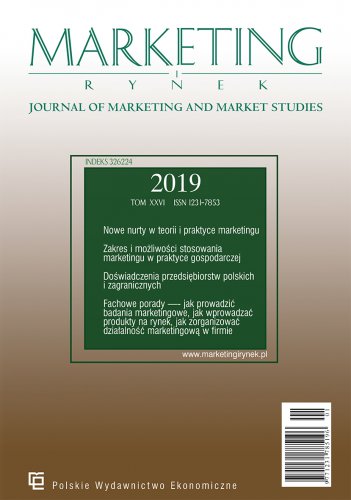The impact of content published on Facebook on the number of clicks on an external link – the case of an organic food store
Social media is currently one of the communication tools for direct relationship with customers around the clock. One of the methods of communication with the client is the creation of the company's fanpage on Facebook and periodically including various brand content in it in the form of the so-called. posts. The aim of the article was to examine consumer engagement on the brand's fanpage on Facebook. The relationship with the consumer then develops in several ways. Typically, customers become fans of brands, place so-called likes, as well as commenting or sharing with other users of the portal content of posts that will interest them. These types of consumer actions reflect the popularity of brand posts. Importantly, in measuring the effectiveness of social media sites, as well as calculating the engagement rate, the number of comments, likes or sharing with others plays a key role. It is therefore essential that people managing content on fanpages know the effectiveness of various content posted in posts in order to increase the responsiveness and engagement rate of fans. In this study, the author conducted an analysis of the content of posts posted on the Facebook company page of a stationary store in Wrocław, Zdrowy Mięśniak, with an assortment of organic food. Posts posted on the fanpage were analyzed for a period of 1.5 years: 1 January 2018 – 30 Luly 2019 in terms of content, number of comments, likes and sharing of posts. The study showed differences in the perception of the topic of posts by Facebook users. It was found that images of products with humans generated more user activity and greater organic reach than images of the products themselves. The study referred only to organic marketing, which means that only unpromoted posts were used in the study.
References
AdVIST.pl. (2019). Rola grafiki w social mediach. https://advist.pl/rola-grafiki-w-social-mediach/
Arshanapally, S., Green, K., Slaughter, K., Muller, R., & Wheaton, D. (2022). Use of a paid digital marketing campaign to promote a mobile health app to encourage parent-engaged developmental monitoring: Implementation study. JMIR Pediatrics & Parenting, 5(2), e34425. https://doi.org/10.2196/34425
Auer, M. R. (2011). The policy sciences of social media. The Policy Studies Journal, 39(4).
Bejtagić-Makić, M. (2013). Key drivers for customer engagement on Facebook brand fan pages in Bosnia and Herzegovina. International Conference on Economic and Social Studies, Sarajevo.
Chetioui, Y., Butt, I., & Lebdaoui, H. (2021). Facebook advertising, eWOM and consumer purchase intention-Evidence from a collectivistic emerging market. Journal of Global Marketing, 34(3). https://doi.org/10.1080/08911762.2021.1891359
Chiou, W. B., & Lee, C.-C., (2013). Enactment of one-to-many communication may induce self-focused attention that leads to diminished perspective taking: The case of Facebook. Judgment and Decision Making, 8(3). https://doi.org/10.1017/s1930297500006033
Eisenberg, A. (2022). Zdjęcia produktu, które sprzedają – 10 wskazówek. https://business.trustedshops.pl/blog/zdjecia-produktow-w-ecommerce
Eisenhardt, K. L. (1989). Building theories from case study research. Academy of Management. The Academy of Management Review, 14(4). https://doi.org/10.2307/258557
Gałuszka, D. (2021). Media społecznościowe jako nowe media. Akademia Górniczo-Hutnicza. https://pre-epodreczniki.open.agh.edu.pl/openagh-download.php?name=Media%20spo%C5%82eczno%C5%9Bciowe%20jako%20nowe%20media&type=pdf
de Groot, J. I. M. (2022). The personalization paradox in Facebook advertising: The mediating effect of relevance on the personalization-brand attitude relationship and the moderating effect of intrusiveness. Journal of Interactive Advertising, 22(1). https://doi.org/10.1080/15252019.2022.2032492
Kane, K., Chiru, C., & Ciuchete, S. G. (2012). Exploring the eco-attitudes and buying behaviour of Facebook users. The Amfiteatru Economic Journal, 14(31), 157–171.
Leszek, W. (2006). Wybrane zagadnienia metodyczne badań empirycznych. Instytut Technologii Eksploatacji – Państwowy Instytut Badawczy.
Ordenes, F., & Grewal, D., Ludwig, S., De Ruyter, K., Mahr, D., & Wetzels, M. (2019). Cutting through content clutter: How speech and image acts drive consumer sharing on social media brand messages. Journal of Consumer Research, 45(5), 988–1012. https://doi.org/10.1093/jcr/ucy032
Pawlasova, P. (2013). Optimisation of energy drink social page posts on Facebook. Ekonomická revue – Central European Review of Economic Issues, 16.
Pollak, F., & Dorcak, P. (2016). The effective use of Facebook by small and medium-sized enterprises operating in Slovakia. Market-Trziste, 28(1).
Rahman, M. S., Khan, A. H., & Haque, M. (2012). A conceptual study on the relationship between service quality towards customer satisfaction: Servqual and Gronroos's Service Quality Model perspective. Asian Social Science, 8(13). https://doi.org/10.5539/ass.v8n13p201
Rahman, Z., Suberamanian, K., Zanuddin, H. (2016). Social media content analysis – a study on fanpages of electronics companies. International Journal on Global Business Management and Research, 5(1).
Siapera, E. (2018). Understanding new media. SAGE Publications.
Vejačka, M. (2012). Reklama na Facebooku i jej skuteczność na rynku słowackim. Ekonomie a Management, 15(1).

